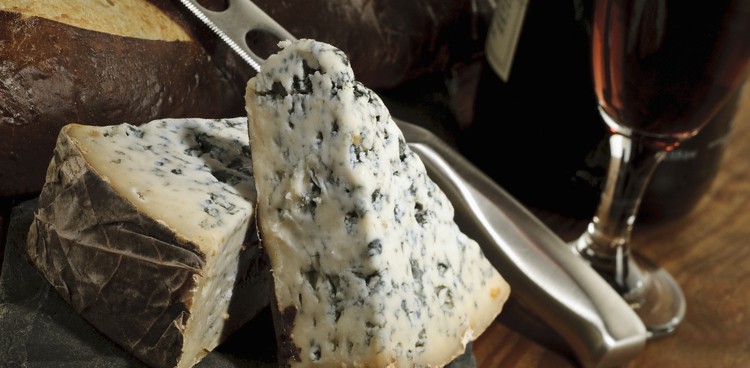
Every holiday season I dream of blue cheese; at Saxelby Cheese, on Manhattan’s Lower East Side, these dreams come true. In a space slightly larger than a broom closet, Anne Saxelby stocks an amazing array of American cheeses, including more than a half-dozen intriguing blues. On a recent visit, I walked away with a creamy, milky-looking round of Maytag Blue, a gorgeous, blue-tinged chunk of Jasper Hill Bayley Hazen, and a wedge of Cayuga Blue from Lively Run Goat Dairy in the Finger Lakes region of New York State before it occurred to me that three blues on one cheese plate might be overkill.
Or it might have been just what I was looking for: A hedonistic, blue cheese bender.
The challenge would be finding a drink to match. Port, of course, is the classic pairing. Grown on the vertiginous, sunny slopes of Portugal’s Douro River Valley, the grapes for Port wines reach prodigious levels of sweetness, which is retained in the wine by a hefty splash of alcohol, killing the yeast and halting fermentation before all the sugars are eaten up. It’s the intensity of these reds in sweetness, alcohol, and pure flavor power that gives them the ability to stand up to an onslaught of richness and penicillin-induced funk.
But in the face of so much great American cheese, it seems lame to look across the ocean for a drink. There are plenty of choices made in closer proximity to these cheeses—and they just aren’t called Port. Or shouldn’t be: Port is a protected designation of origin (PDO), just like Comté or Roquefort, but some American wineries still use the term under a grandfather clause. Quady Winery in Madera, Calif., which specializes in sweet wines, calls its example Starboard, and Justin Vineyards & Winery in Paso Robles sells a wine called Obtuse. Others leave it at “red dessert wine,” while the Sweet and Fortified Wine Association in California has floated “Fort” and “Forté” as alternative terms.
No matter the name, there’s style within the style to decide on; there is no one definitive idea of Port-style wine. That said, they do fall into two major camps: bottle-aged (the fruity ones, which may be either a blend of vintages or the product of just one exceptional vintage) and wood-aged (which linger in wooden barrels for years until they’ve turned tawny in color and nutty in flavor).
Which go best with which blue? It depends entirely on what you’re looking for. If it’s refinement and restraint you value, a well-aged, tawny-hued wine is the way to go—it’s less sweet than its purple cousins, with translucent layers of flavor, so a restrained, creamy blue won’t get lost. (A wine like Prager Winery and Port Works Tawny is light enough to let the milky notes of a Maytag Blue through while cutting its richness.)
A cheese with more earth, funk, and density works better with a wine that shares some of those characteristics, as many of the wines made with Portuguese varieties do. (Try Cayuga, for example, with a wine like Prager’s Tomás or Heitz Cellar Ink Grade: they have herb-tinged, wild blackberry flavors that kick up the cheese’s goaty, herbal notes.)
The Zins tend to be more evenhanded; their heavy-gauge velvet texture wraps around whatever tang the cheeses put forth without mowing over their complexity.

Photo Credit: Jay B. Sauceda
Fruity Styles
- Prager Winery and Port Works Napa Valley Tomás Port, $52 / 750ml
- Sonoma Valley Portworks 2005 Clarksburg Aris, $30 / 375ml
Tawny Port-Style Wines
- Ficklin Vineyards Madera Aged 10 Years Tawny Port, $28 / 750ml
- Prager Winery and Port Works Napa Valley Noble Companion Tawny Port, $65 / 750ml
Late-Harvest Zinfandels
- Dashe 2007 Dry Creek Valley Late Harvest Zinfanfel, $24 / 750ml
- Easton 2006 Fiddletown Rinaldi Vineyard Late Harvest Zinfandel, $20 / 500ml
- Rosenblum 2006 California Late-Harvest Rosie Rabbit Zinfandel, $18 / 375ml
Feature Photo Credit: “Bleu Cheese And Port Wine” by Cameron Whitman | Shutterstock




